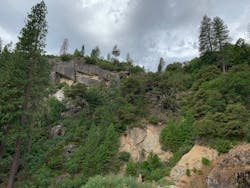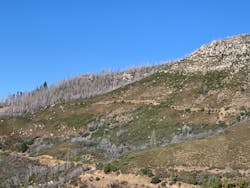The old adage, "If a tree falls in the woods…" ignites an exploration of the impact nature has on human experience, whether personally felt or not. In what has been the worst wildfire season in history, the same adage bears consideration. Whether it’s fallen trees, vegetation growth, wildlife impacts, or any other myriad circumstances that seem to happen in isolation, the greater impact of these events may necessitate further exploration, monitoring, and evaluation. Would additional information have better prepared us for limiting the scope of destruction or even prevented a wildfire?
According to the National Interagency Fire Center, from Jan. 1 through Nov. 6, 2020, about 8.6 million acres burned in wildfires compared to 4.6 million acres over the same period in 2019. Six of the top 20 largest California wildfires on record occurred in 2020. Beyond the devastation to personal property and risk to life, wildfires also cause extensive damage to electrical infrastructure that results in large capital expenditures. And if a wildfire is caused by a downed power line, the potential financial responsibility could be astronomical.
Predictive metrics for wildfire risk typically start with a discussion about climate change and its impact on weather and vegetation. However, it may be worth considering how other, lesser-known risk factors may impact wildfire risk and the associated financial and infrastructure impacts on power transmission and distribution.
As a professional geologist, I enjoy observation and comparative analysis. When applied toward risk assessments for wildfires over the course of decades and combined with recent field reconnaissance surveys, I am left wondering whether we’re doing enough to manage risks to electrical infrastructure and limit financial liability.
What do we know about wildfire risks?
Many drivers impact the risk of wildfires and the ways they ignite and grow. As we study previous wildfires, several of the interrelated risk drivers are commonly discussed.
Climate change
Warmer temperatures reduce snowpack and bring about an earlier melt — creating longer, more intense dry seasons. Over time, this has increased droughts, which stresses vegetation, increases tree mortality, and causes greater susceptibility to disease or insect infestation. These conditions result in dry trees and brush, which are easier to ignite and have a significantly faster burn rate.
Vegetation
Fire risk is partially dependent upon vegetation type. Some vegetation burns quickly (for example, dry grass), while other types burn hotter (for example, hardwood trees such as oak). Each vegetation type presents unique challenges for vegetation management and control. Additionally, vegetation density directly affects wildfire hazards. Dense vegetation generally represents the highest hazard level, while sparse vegetation density is substantially lower risk. Several factors contribute to vegetation density, including weather conditions, precipitation, and local micro-climates.
Weather
Weather conditions — including precipitation, humidity, storms, and winds — impact wildfire risks. Lightning strikes, both those associated with thunderstorms and also dry lightning, are a common natural cause of wildfires. In August alone, nearly 14,000 lightning strikes started almost 900 fires in California over a three-day period. Dry lightning strikes are known, at times, to smolder for weeks before causing "holdover fires." High winds drive wildfire growth but may also down trees and sometimes power lines, which has caused several major wildfires in California.
Terrain
Topography and terrain affect wildfire migration and area-specific risks. Generally, fires move upslope without winds, but high winds (for example, Diablo winds in northern California and Santa Ana winds in southern California) rapidly drive fires in the same direction as the winds. Both scenarios represent rapid wildfire growth and increased hazard.
What are we missing about wildfire risks?
While there is no denying the significance of longer dry periods, higher temperatures, more extreme weather and stressed, disease-susceptible vegetation, there may be other factors not as commonly considered or discussed.
Fire history
Fire history affects wildfire risks. Vegetation changes are directly associated with wildfires. In addition to consuming existing vegetation, the new landscape is open to different vegetation types, both native and invasive. With native vegetation, a natural cycle occurs with different species dominating the environment and evolving over an extended timeframe. Since different vegetation types represent varied fire hazards, the risk level also evolves over time in conjunction with vegetation changes.
Tree mortality
While conducting field reconnaissance surveys in 2019 and 2020 in support of wildfire mitigation evaluations, I observed that there were many trees that were not entirely consumed by the fires but still the fires caused them extensive stress. Couple this stress with drought conditions, and the surviving trees have little sap left to fend off bark beetle attacks. The result is weakened, dried-out trees that become risk hazards as quick-burning fuel for wildfires.
Landslides and debris flows
In the geologic world, there are several different forms of naturally occurring mass earth movement events — landslides, rockfalls, debris flows, and mudflows, to name a few. Some of these events present direct risks, such as a landslide or rockfall downing power lines. Landslides can sever or damage tree roots, stressing the trees or causing mortality, which increases potential wildfire hazards. They can also create post-wildfire hazards that can result in extensive property damage.
Finally, although blocked or impassable access roads from these events do not cause wildfires, they do present an indirect potential liability. They inhibit inspections and interfere with emergency response. We are currently evaluating access roads for a utility client, surveying for a variety of road conditions that could lead to restricted access. Some examples are roads overgrown with trees and heavy brush, landslide-damaged roads, washouts near drainage channels or access blocked by large boulders and downed trees.
Wildlife
Raptors, rodents, cattle, and other wildlife can affect electrical equipment. During my decades of utility experience, I have heard about or personally seen the destructive power of wildlife. For instance, I saw the results of a bear marking its territory by deeply scratching a wooden electric distribution pole deep in the forest. Woodpecker damage to wood poles is common. I recently observed such extensive damage that the guy attached began to collapse into a pole that had been hollowed out by woodpeckers for nesting.
I have also viewed or heard from clients how wildlife directly caused outages. In the first scenario, a rope hung from a large osprey nest atop a steel transmission pole. When the rope contacted the conductors, it caused an outage. The most surprising story I’ve been told was about a vulture dropping a deer carcass on a line, resulting in an outage.
Fortunately, none of these scenarios directly caused a wildfire. However, it may be worth considering the larger direct and indirect impacts of wildlife on electrical equipment. Can these impacts be prevented or minimized, thus reducing the risk of wildfires they may cause?
Recommendations for reducing risk
A series of recent northern California wildfires underscores the risks to electrical infrastructure. The 2015 Valley Fire, 2017 Tubbs Fire, 2019 Kincade Fire, and 2020 Glass Fire caused extensive damage to the Napa-Sonoma County Wine Country. The 2015 Valley Fire, resulting from downed power lines, caused extensive damage to power plants and distribution lines at Geysers geothermal area. How much could have been done to prevent the downed lines may never be determined. Although the fear of liability is implicit with studying and documenting potential risks, so, too, is the liability for risks that remain unchecked.
While it remains paramount to continue monitoring the primary drivers for wildfire risk (for example, climate change and vegetation), is it time to explore other factors impacting wildfire risk mitigation? Here are a few actions to incorporate in your planning if you haven't already:
- Review current inspection and maintenance programs to ensure that they are capturing critical information.
- Where applicable, increase the use of unmanned aerial vehicles (UAVs) for infrastructure inspections. This would enable close inspection of infrastructure that is difficult to access, allowing identification of potential structural or biological hazards (for example, woodpecker damage).
- Revise current inspection and maintenance programs and determine whether other potential hazards such as landslides, rockfalls, and tree falls exist. If applicable, address and mitigate relevant potential risks for the conditions in the local facility area.
- Evaluate vegetation clearing and control programs to ensure that processes and procedures are not creating potential new environmental liabilities, such as erosion and sediment runoff into jurisdictional streams and waterways.
- If applicable, coordinate with nearby electrical utilities to determine if their operations present possible beneficial practices or activities that may be appropriate for your operations.
Moving forward with proactive, comprehensive strategies
The trend over the past few years indicates wildfire risk and the resulting potential impact to electrical infrastructure will only continue to grow. Understanding, assessing, and attempting to minimize wildfire risks is complicated, time consuming, and costly. But so is mitigating the impacts to infrastructure and human and natural habitat after a wildfire.
Some of our clients are investing in proactive measures such as hardening systems to limit ignition sources, relocating distribution lines to lower-risk corridors, and updating monitoring systems that can quickly identify and respond to disruptions. Are there other factors explored in this article we could add to the list of strategies? Broadening the considerations of risk drivers may reduce overall potential liability. The more prevention that can be done, the less the overall cost — to habitat, to reputations, and to existing infrastructure.
About the Author
Brent Miyazaki
Brent Miyazaki is a senior project manager in the environmental division at POWER Engineers. For more than 30 years, his career has focused on impact assessment and NEPA compliance for complex multidisciplinary projects in a variety of industries: transmission and distribution, renewables, transportation, and oil and gas. He has written several technical papers and presented at conferences on the topic of applying risk-based techniques for impact assessment. Most recently, he is applying his expertise to help clients consider the environmental factors as they harden their systems to reduce fire risks.

